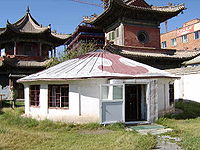
Choijin Lama Monastery
Encyclopedia

Mongolia
Mongolia is a landlocked country in East and Central Asia. It is bordered by Russia to the north and China to the south, east and west. Although Mongolia does not share a border with Kazakhstan, its western-most point is only from Kazakhstan's eastern tip. Ulan Bator, the capital and largest...
.
Actually a group of four temples originally occupied by the Choijin Lama Luvsankhaidav, the brother of the ruler Bogd Khan
Bogd Khan
The Bogd Khan was enthroned as the Great Khaan of Mongolia on 29 December 1911, when Outer Mongolia declared independence from the Qing Dynasty after the Xinhai Revolution. He was born in the Kham region of eastern Tibet, today's Sichuan province of the People's Republic of China...
, who was the state oracle at the same time. The complex was begun in 1904 and completed in 1908. In 1938 the Stalinist government converted the complex into a museum.
The main temple features an 18th-century gilt statue of Buddha Sakyamuni with a statue of Choijin Lama Luvsankhaidav on the Buddha's right and the embalmed corpse of Baldanchoimbolon on his left. In addition, the temple boasts a copious collection of religious instruments, thangka
Thangka
A "Thangka," also known as "Tangka", "Thanka" or "Tanka" is a Tibetan silk painting with embroidery, usually depicting a Buddhist deity, famous scene, or mandala of some sort. The thankga is not a flat creation like an oil painting or acrylic painting...
paintings, a copy of the 108-volume Kangyur
Kangyur
The Tibetan Buddhist canon is a loosely defined list of sacred texts recognized by various schools of Tibetan Buddhism, made up of the Kangyur or Kanjur and the Tengyur or Tanjur .-The Tibetan Buddhist Canon:In addition to earlier foundational Buddhist texts from early Buddhist schools, mostly...
and hand-printed 226-volume Tengyur
Tengyur
The Tengyur or Tanjur is the Tibetan collection of commentaries to the Buddhist teachings, or "Translated Treatises"...
brought from Tibet
Tibet
Tibet is a plateau region in Asia, north-east of the Himalayas. It is the traditional homeland of the Tibetan people as well as some other ethnic groups such as Monpas, Qiang, and Lhobas, and is now also inhabited by considerable numbers of Han and Hui people...
by the Bogd Khan, and a collection of cham dance
Cham Dance
The cham dance , also spelled tscham or chaam, is a lively masked and costumed dance associated with some sects of Buddhism, and is part of Buddhist festivals. The dance is accompanied by music played by monks using traditional Tibetan instruments...
masks).
The annex to the temple contains a heated ger
Ger
Ger may refer to:*Ger , a Hasidic dynasty from Góra Kalwaria*Ger , the javelin of the Germanic tribe of the Teutons*Germany *German language *Granular endoplasmic reticulum *Gross Enrollment Ratio...
(or yurt
Yurt
A yurt is a portable, bent wood-framed dwelling structure traditionally used by Turkic nomads in the steppes of Central Asia. The structure comprises a crown or compression wheel usually steam bent, supported by roof ribs which are bent down at the end where they meet the lattice wall...
) and a central square in which Choijin Lama Luvsankhaidav performed rituals.
The Zuu Temple, dedicated to the Buddha Shakyamuni features papier-mache
Papier-mâché
Papier-mâché , alternatively, paper-mache, is a composite material consisting of paper pieces or pulp, sometimes reinforced with textiles, bound with an adhesive, such as glue, starch, or wallpaper paste....
sculptures of Buddha in the past, present, and future. The 16 disciples of Buddha appear on the temple walls with four Maharantsa protectors shown sitting in caves on either side of the door.
The Yidam
Yidam
In Vajrayana Buddhism, an Ishta-deva or Ishta-devata is a fully enlightened being who is the focus of personal meditation, during a retreat or for life. The term is often translated into English as tutelary deity, meditation deity, or meditational deity...
Temple was used as a place of prayer by Choijin Lama Luvsankhaidav, and therefore closed to the public. In its center is a gilt bronze sculpture of one of the 84 India
India
India , officially the Republic of India , is a country in South Asia. It is the seventh-largest country by geographical area, the second-most populous country with over 1.2 billion people, and the most populous democracy in the world...
n yogis, or Mahasiddha
Mahasiddha
Mahasiddha is a term for one who cultivates those teachings that lead to becoming perfect. They are a type of eccentric yogini/yogi in both Sanatan Dharma and Vajrayana Dharma, given by Siddhartha. Mahasiddhi are those practitioners, or tantrikas who have gained sufficient understanding and are so...
. Also depicted are the tantric
Vajrayana
Vajrayāna Buddhism is also known as Tantric Buddhism, Tantrayāna, Mantrayāna, Secret Mantra, Esoteric Buddhism and the Diamond Vehicle...
gods Kalacakra, Mahamaya, Vajradhara
Vajradhara
Vajradhara is the ultimate primordial Buddha, or Adi Buddha, according to the Gelug and Kagyu schools of Tibetan Buddhism.In the evolution of Indian Buddhism, Vajradhara gradually displaced Samantabhadra, who remains the...
and others with their shakti
Shakti
Shakti from Sanskrit shak - "to be able," meaning sacred force or empowerment, is the primordial cosmic energy and represents the dynamic forces that are thought to move through the entire universe in Hinduism. Shakti is the concept, or personification, of divine feminine creative power, sometimes...
or consorts in postures of meditation that symbolize power and strength.
The fourth temple, the temple of amugulang or peace, is dedicated to the first Mongolian reincarnation of Boghda Jevzundamba, Undur Gegeen Zanabazar, (1635-1724).1

